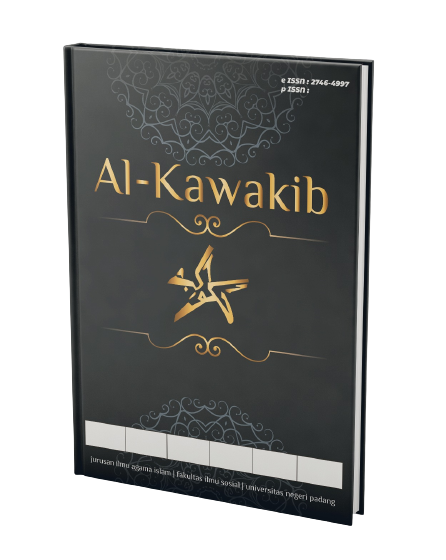Structure of Epistemology and Sufism Patterns on Malay-Jawi Interpretation: The Case of Q.S. Al-Fatihah Interpretation in Nurul Ihsan by Said bin Umar, Kedah
Abstract
Intellectual relationships and domicile can influence shaping a person's mindset. Including Said bin Umar is a scholar who concentrates on Sufism or tarekat. Therefore, it is essential to explore its interpretation when interpreting Q.S. al-Fatihah, because there could be nuances of the esoteric-Sufistic interpretation carried out by Said bin Umar. This research is a type of library research with the formal object of Tafsir Nurul Ihsan by Said bin Umar, and the material object is the interpretation of Q.S. al Fatihah. The conclusion of this article explains that Said bin Umar internalized his esoteric-Sufistic interpretation when interpreting verse 1 (basmalah) and verse 5 of Surah al-Fatihah. As for the factors that shape the emergence of esoteric-Sufistic reasoning, Said bin Umar when interpreting Q.S. al-Fatihah, are 1) The intellectual relationship of his teachers, 2) Anthropic-social configuration before and during comment writing, and 3) Relationships and tendencies of other literary with a written interpretation.
Downloads
References
Adinugraha, H. H., Anas, A., & Nuswantoro, U. D. (2018). ( Analisis Terhadap Teori Hudūd Muhammad Syahrur ) the Islamic Law Reactuality in Indonesia ( an Analysis of Muhammad Syahrur ’ S Limit Theory ). Islamadina Jurnal Pemikiran Islam, 19(1), 1–26.
Ahmad, M. N., Faizulamri, M., & Saad, M. (2018). Metodologi Muhammad Sa ’ id Umar Terhadap Periwayatan Hadith-Hadith Asbab al-Nuzul Dalam Tafsir Nurul Ihsan Muhammad Sa ’ id Umar ’ s Methodology on the Narration of the Hadiths of Asbab al-Nuzul In the Tafsir Nurul Ihsan. 3(1), 12–23.
Ahmad, M. N., Najib, M., Kadir, A., & Hussin, H. (2016). Pengaplikasian Kaedah Tafsir al-Qur’an dengan Qira’at oleh Muhammad Said bin Umar di dalam Tafsir Nurul Ihsan. AL-TURATH JOURNAL OF AL-QURAN AND AL-SUNNAH, 1(1), 65–73. https://spaj.ukm.my/jalturath/index.php/jalturath/article/view/9
Azyumardi Azra. (2004). Jaringan Ulama Timur Tengah Dan Kepulauan Nusantara Abad XVII Dan XVIII. Kencana.
Berapa Lama Waktu yang Dibutuhkan untuk Mengubah Kebiasaan? Halaman all - Kompas.com. (n.d.). Retrieved January 9, 2022, from https://sains.kompas.com/read/2018/06/12/203600823/berapa-lama-waktu-yang-dibutuhkan-untuk-mengubah-kebiasaan-?page=all
Gadamer, H.-G. (2013). Truth and Method. Bloomsbury.
Gusmian, I. (2015). “Tafsir al-Qur’an di Indonesia: Sejarah dan Dinamika". Jurnal NUN: Jurnal Studi Al-Qur’an Dan Tafsir Di Nusantara, 1(1), 4–5.
Hamka. (1989). Tafsir Al Azhar. Pustaka Nasional PTE LTD.
Harun, M. F. (2015). Tasawuf Dan Tarekat Sejarah Perkembangan Dan Alirannya Di Malaysia. UUM Press.
Ismail, N. B. (2017). The Qur’anic exegesis, reformism, and women in the wentieth century Indonesia. Studia Islamika, 24(3), 469–501. https://doi.org/10.15408/sdi.v24i3.5187
Machi Jehsor. (2020). MAKNA AULIYA’ DALAM AL-QUR’AN MENURUT MUHAMMAD SA’ID DALAM TAFSIR NURUL IHSAN. UIN Surakarta.
Michel Foulcault. (1976). The Archaeology of KKnowledge Row Publisher.
Mike Michael. (2017). Actor-Network Theory. SAGE Publications.
Moch. Faizal Harun dan M. Hazwan. (2018). Sejarah Tarekat : Pertumbuhan dan Penyebaran Di Dunia Islam. UUM Press.
Muliati, I., Sulaiman, S., Hoktaviandri, H., & Rahman, R. (2020). Pemikiran Pendidikan Muhammad Abduh. Jurnal Kawakib, 1(1), 44–53. https://doi.org/10.24036/kwkib.v1i1.12
Mustaqim, A. (2008). Pergeseran Epistemologi Tafsir. Pustaka Pelajar.
Mustaqim, A. (2010). Epistemologi Tafsir Kontemporer. LKiS.
Nazri Ahmad, M., Fareez Noorazalan, I., Ishak, H., Kajian al-Quran dan al-Sunnah, P., & Pengajian Islam UKM, F. (2021). Asbab Al-Nuzul di dalam Tafsir Nurul Ihsan. AL-TURATH JOURNAL OF AL-QURAN AND AL-SUNNAH, 6(2), 62–67. https://spaj.ukm.my/jalturath/index.php/jalturath/article/view/191
Parwanto, W. (2019a). Struktur Epistemologi Naskah Tafsir Surat Al-Fatihah Karya Muhammad Basiuni Imran Sambas, Kalimantan Barat. Jurnal At-Tibyan: Jurnal Ilmu Alquran Dan Tafsir, 4(1), 143–163. https://doi.org/10.32505/tibyan.v4i1.783
Parwanto, W. (2019b). Struktur Epistemologi Naskah Tafsir Surat Tujuh (Tujuh Surat) Karya M. Basiuni Imran, Sambas : Kalimantan Barat. UIN Sunan Kalijaga.
Rahmah, N. (2018). Sullam al - Mustafidin: The Theological Discourse in Aceh in 17th Century. Heritage of Nusantara: International Journal of Religious Literature and Heritage, 7(2), 167–197. https://doi.org/10.31291/hn.v7i2.529
Rahman, A., Hitami, M., & Darussamin, Z. (2018). Tafsir Melayu: Mengenal Tafsir Nūr Al-Ihsān Karya Syekh Muhammad Sa’Īd Al-Qadhī. Jurnal Ushuluddin, 26(1), 1. https://doi.org/10.24014/jush.v26i1.4071
Riddell, P. G. (2014). Variations on an Exegetical Theme: Tafsīr Foundations in the Malay World. Studia Islamika, 21(2), 259–292. https://doi.org/10.15408/sdi.v21i2.1072
Said bin Umar al-Kedah. (n.d.). Tafsīr Nūr al-Ihsān. Maktabah wa Mathba’ah Muhammad al-Hindi wa Awladih.
Sheh Yusuff, M. S., Haji-Othman, Y., & Zawawi, T. Z. T. (2021). Developing a Method of Understanding Tafsir Nur Al-Ihsan Using Intertextual Reading: A Study using the Excerpt Method. International Journal of Academic Research in Business and Social Sciences, 11(6), 127–134. https://doi.org/10.6007/ijarbss/v11-i6/10102
Shihab, M. Q., Yatim, B., Sukardja, A., Rosyada, D., & Umar, N. (1999). Sejarah Ulum Al--Qur’an (A. Azra (Ed.)). Pustaka Firdaus.
Sri Mulyati., M. (2006). Tasawuf Nusantara : rangkaian mutiara sufi terkemuka. 255.
Sugiyono. (2017). Metode Penelitian Kualitatif, Kuantitatif dan R&D. Alfabeta.
Syamsuddin, S. (2021). DIFFERING RESPONSES TO WESTERN HERMENEUTICS A Comparative Critical Study of M. Quraish Shihab’s and Muhammad ‘Imara’s Thoughts. Al-Jami’ah, 59(2), 479–512. https://doi.org/10.14421/ajis.2021.592.479-512
Yusuff, M. S. S., Haji-Othman, Y., & Fisol, W. N. M. (2021). Investigating the Influence of Tafsir Works Using Parallel Method of Intertextuality theory in Tafsir Nur al-Ihsan by Umar, M. S. International Journal of Academic Research in Business and Social Sciences, 11(11), 670 – 677. https://doi.org/10.6007/IJARBSS/v11-i11/11562
Copyright (c) 2022 Wendi Parwanto

This work is licensed under a Creative Commons Attribution-ShareAlike 4.0 International License.


1.jpg)





.PNG)
.PNG)




3.PNG)
2.PNG)



